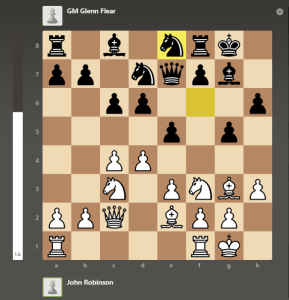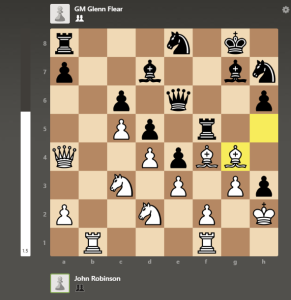John Robinson vs Glenn Flear, British Championship Qualifier Tournament, 29/11/1976.
In this series we will look back at some of the games of John Robinson against chess masters. One of our most decorated players(currently rated 1967 FIDE), John has had decades of experience and has played against some of the biggest names in chess.
Today we look at a game John played more than 40 years ago against Leicester’s first Grandmaster(GM) Glenn Flear. The game took place as part of a Qualifier tournament for the British Championship in 1977. Although not a master at the time, Glenn Flear had already establised himself as a promissing young chess player who was destined to reach the highest levels of the game. John on the other hand was looking to qualify again for the biggest British chess competition after winning a spot for the 1972 British Championship.

Unfortunately for the future Grandmaster his game against our teammate turned into a disappointing loss. Playing with the white pieces, John started the game with 1. d4 which was met by the King’s Indian defence by Flear.
“He was regularly playing the King’s Indian Defence, so I was not surprised at all.” John remembers “On the other hand, I was often playing the Smyslov variation which specialises in advancing on the queen side while simultaneously being very solid on the king side.”
1.d4 Nf6 2. c4 g6 3. Nc3 Bg7 4. Bg5 d6 5. Nf3 O-O

Both players continued their development in a typical for this position way until move 8 when Black decided to start the middlegame proceedings with the thematic pawn break e5:
6. e3 Nbd7 7. Be2 c6 8. O-O e5

Although White appears to be slightly better in the above position, the tactical nature of the King’s Indian ensures that there is always an opportunity for either player to obtain advantage. Unmoved by the aforementioned pawn break, John continued with his plan, as did Glenn Flear. Both players carried on with the preparation of their attacks, with the future GM being slightly more active and chasing John’s dark-squared bishop back to the third rank with the benchmark h6-g5 pawn advance.
9. h3 Qe7 10. Qc2 h6 11. Bh4 g5 12. Bg3 Ne8

At this point John was conscious of the fact that the attack has started. Later in the postmortem of the game, he would write in his notebook: ‘Glenn plays for the attack on the king side, while White must press on the queen side.’ Sensing the imminent 13…f5, John decided that it is appropriate to respond to the threat with a threat of his own.
13. b4 f5 14. Rad1 e4
Black seemed to be already at the castled king’s door, but in the spirit of the Smyslov variation, John was prepared for the advance and stroke back on the queen side. However, he is interested in the last move and in his analysis after the game he wrote in his notebook: ’14…f4 might be better but leaves a lot of weak squares around the black king.’
“I was not surprised at any point during the game, to be honest.” John recalls. “I had played those Smyslov positions for a while, so I was prepared for the attack on the king side.”
While Black shuffled his pieces around in an attempt to break the blockade around the white king, John initiated an attack of his own by striking in the centre with c5. When the future GM decided to push d5 and close the centre, John continued with his plan to attack on the queen side with the powerful b5, further opening the b-file.
15. Nd2 Ndf6 16. c5 d5 17. b5 Nh7 18. bxc6 bxc6 19. Qa4 Rf6 20. Bh5!

In the analysis of the game, John places an exclamation mark on the last move and writes in his notebook: ‘A rather annoying move for Black to face.’
Although there is no difference in material, Stockfish (depth = 20) evaluates the last position as +1.3 with clear advantage for White. With John’s rook placed on b1 eyeing the freshly opened file and White’s infiltration on the queen side approaching fast, Black launched a counter-attack with f4. White’s setup proved difficult to break and despite the pawn storm on the king side, John managed to consolidate his position. The attack, however, proved that Black still had his chances and the engine gives high reward for Black’s initiative by evaluating the resulting position as roughly equal.
20. …Bd7 21. Rb1 f4 22.. Bh2 g4 23. Bxf4 gxh3 24. g3 Qe6 25. Kh2

Met with a strong defence, Black decided to be creative and sacrificed a rook in the hope of opening White’s blockade. The sacrifice, however, does not quite work and even though John evaluates the move as interesting, the engine’s estimation is far less generous and its evaluation is +1.5 after White’s light-squared bishop exerts a relative pin on the rook.
John explains the rationale behind this sacrifice: “He knew that there is no stopping White on the queen side while Black is basically stuck on the king side. He had to be creative in order to take the initiative and try and prise open White’s position.”
25…Rf5 26. Bg4

Down an exchange after the bishop takes the rook, Black was aware that there is no stopping of the queen side infiltration and threw everything in the charge of the white king’s fortress, engaging all pieces in the attack. In the meantime, confident in the solidity of his position, John parried all attacking attempts while placing his rook on the seventh rank preparing to destroy Black’s queen side.
26…Nef6 27. Bxf5 Qxf5 28. Rb7 Ng4+ 29. Kh2 Ng5 30. Qb3 Rf8

At this point the game was adjourned. In the pre-engines era, adjourning games was quite common and it basically meant that the players will finish at some point in the future.
“We had a lot more time for a game than now.” John remembers “An hour and a half for 30 moves, and after the thirtieth move we were allowed to adjourn the game. I had to write down my next move and place it in an enclosed envelope, then hand it to one of the officials. I don’t remember exactly, but it was at least a couple of days until we got to finish our game.”
The engine evaluates the position as +3.2. Even in the old days, Glenn Flear must have known that White is winning and he needs to do something extraordinary in order to win. A few days later the envelope was opened to reveal a simple rook move picking up a pawn. As John describes it: “I knew he will have hard time penetrating the defence on the king side, so I just picked up the hanging pawn.”
31. Rxa7 Be6 32. Rc7 Nf3
After moving the bishop away from the powerful rook, Black launched one last attack on the king side, starting with a knight exchange. John brought his queen back to the defence of the king while the future GM set up one last trap with a knight sacrifice.
33. Nxf3 exf3 34. Qd1 h2 35. Rxc6 Ne5

An experienced chess player, Jonh spotted the trap and calmly took the knight with his pawn. He later writes in his notebook: “Hoping for 36 Bxe5 when 36…Qh3 would prove fatal for White.” Finding himself completely losing, with the perspective of playing an endgame where his opponent has two passed pawns and a full rook, Black resigned.
36. dxe5 1-0

Stockfish evaluates the final position as +6.4 with a clear advantage for White. An amazing game from John against a strong opponent.
John remembers: “Glenn went on to win the section and qualify to play in the British Championship (at 17 years of age!) and later (in 1986) became the first official Grandmaster in Leicester.”
John did not succeed in qualifying for the British Championship in 1977. Nevertheless, a brilliant game from our teammate and a valuable lesson for every player engaging in the Smyslov variation.
Pingback: Three in a row for Anstey 1 after a glorious victory! | Anstey Chess Club